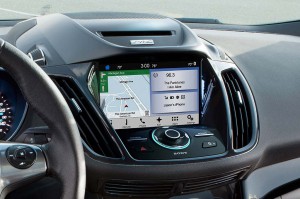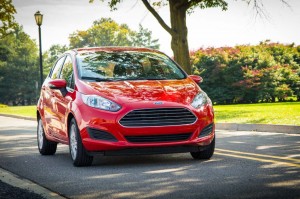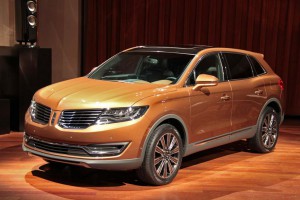Hoping to hold its lead against increasingly aggressive rivals, Ford Motor Co. will launch its completely redesigned Sync 3 infotainment system this summer on the 2016 Ford Escape and Fiesta models.
Launched in 2007, and among the first to offer such features as voice and touch control, smartphone app integration and other communications and navigation services, the original Sync helped draw a generation of tech-savvy buyers to Ford. But it also earned the maker plenty of criticism for the system’s failures and weaknesses.
One surprise: Ford’s latest version of Sync will not – at least for now – include the Apple CarPlay and Android Auto systems. But Sync 3 does improve on the earlier AppLink technology that can integrate a variety of smartphone apps, as well as Sire Eyes-Free which can tap into an iPhone’s voice-operated personal assistant.
SYNC always has been about providing a safer way for our customers to connect their smartphones in order to keep their eyes on the road and hands on the wheel,” said Mark LaNeve, Ford’s vice president, of U.S. Marketing, Sales and Service. “Customers continue to tell us they want this technology, and they want it to be fast and easy to use – like a smartphone. SYNC 3 delivers on that request.”
(Chevy adding Android Auto, Apple CarPlay to 14 different models for 2016. Click Here for more.)
The desire for more advanced infotainment technology has been highlighted by a number of recent reports, including the inaugural J.D. Power Tech Choice Study. Only advanced safety systems tend to place higher on shoppers’ must-have lists.
Ford developed the original Sync system in a partnership with Microsoft, but the updated Sync 3 comes as a setback for the tech giant which was largely pushed out of the project, replaced by Canada’s QNX, the owner of the once popular Blackberry smartphone. That alliance underscores the dangers of the tech world where a once-thriving and dominant brand can falter badly if it misses a step and lets competitors move ahead.
Ford intends to avoid that mistake, and for good reason. Company officials have claimed that Sync has played at least some role in the purchase decision by millions of buyers in the years since its introduction. It is now installed on about 12 million vehicles sold worldwide. But earlier versions of Sync also caused the maker some major headaches.
(Hyundai Sonata to introduce Android Auto for 2016. Click Here for more.)
Problems, especially with slow response times, the poor performance of its voice system, and a complex command structure, have earned Ford some serious demerits in recent quality studies by J.D. Power and other research firms.
Ford says it has set out to overcome those concerns with Sync 3. Among other things, it has strived to develop a voice recognition system that can respond to requests and commands made in a more conversational tone. No more learning five very specific steps in order to pair a new phone, for example.
In early demonstrations, the system also operated much more quickly, and featured a much simpler, intuitive graphical user interface on the touchscreen.
Along with Siri EyesFree and AppLink, the new Sync 3 will introduce the ability to receive software updates wirelessly. That’s a useful step forward. Ford had to issue memory sticks – or send non-tech-savvy customers to showrooms – several years ago when it ran into problems with the last-generation Sync. That marred the launch of the then-new Lincoln MKX.
Other makers also are working up wireless update systems, and Tesla Motors recently began using its own version to improve the functionality and range of its electric sedan, the Model S. Meanwhile, OnStar, General Motors’ telematics provider, will next year introduce the ability to diagnose and alert motorists to potential vehicle problems, such as a failing battery.
Few observers would be surprised if Ford adds such features to the evolving Sync system, perhaps in short order. The maker has said it won’t wait for traditional automotive cycles – which can run four to eight years – to upgrade the system.
The new Sync 3 will debut on the 2016 Ford Escape and Fiesta models over the summer, targeting two product lines that have strong appeal to younger, more tech-savvy buyers. On the Lincoln side, it will first appear in the next-generation 2016 MKX. Sync 3 then “will migrate to all Ford vehicles in North America by the end of the year,” according to a Ford statement.
(Ford, Microsoft team back up on new project. Click Here to learn what it’s about.)



